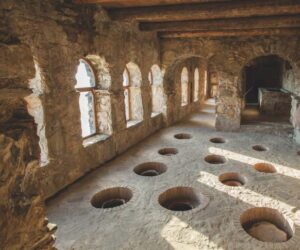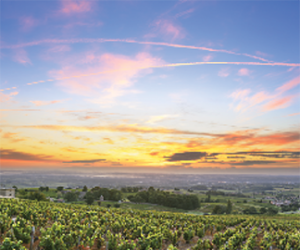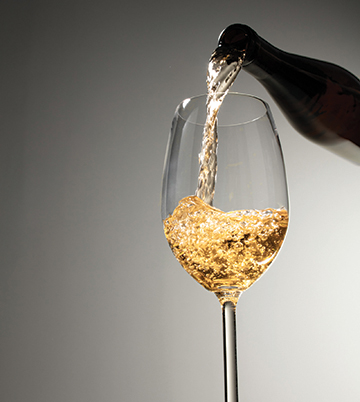
It was a very warm evening in the shadows of the Vosges Mountains, as the last several summers have been in Alsace, France. My wife and I were on the patio of our good friends’ Jacques and Laura’s winery in Hunawihr, drinking wine, talking about family, old times, wine, and anything else that came to mind. The conversation was delightful, so much so that Jacques noticed the drinking had slowed down. As comedic as ever, he incredulously looked at our glasses and went to the “magic refrigerator.” He produced a fresh bottle of cold crémant, took our glasses, threw the warm contents into geranium window boxes, and announced, “Life is too short for warm wine!” Naturally we were drawn to the conversation of warming conditions for winemakers and how best we adjust to the growing challenges of winemaking.
The history of Alsace, which has always included wine, includes turmoil and challenges to each generation. There have been numerous changes of power from early Roman control followed by a plethora of treaties amongst the neighboring states when the Romans were run out. In about 1618, King Louis VIII started annexing portions of Alsace, gaining complete control in 1674 and continuing to 1870, when the Franco-Prussian War started. At the end of that war in 1871, the region was ceded to Germany. In 1919, at the end of WWI, the Treaty of Versailles ceded Alsace back to France, and Nazi Germany conquered the region in 1940 for the duration of WWII. World War II had a significant impact on the region with battles fought throughout the area. Alsatians persevered, but it came at great costs. To preserve their culture, they went to great measures to see that they didn’t have to fight their brothers and cousins. After the Second World War, the region returned to French control.
Touring the Alsace countryside, you can only be reminded of this diverse history set amongst the modern-day vineyard and wine industry that has been revitalized. It is no wonder that most Alsatians see themselves as a semi-autonomous region. On any given day, my friend Jacques will speak French, German, English, and the local dialect of Alsatian, which is spoken on both sides of the French/German border. The modern-day border is the Rhine River, situated in a valley between the Vosges Mountains of France to the west and the Black Forest of Germany to the east.
There are close to 40,000 acres (15,500 hectares) of vineyards in Alsace. Within this area there are 51 Grand Cru Appellation d’Origine Protégée (AOP) localities. Their three-tier AOP (formerly AOC) system is probably one of the easiest in France to understand, as you only must remember three! But the Alsatian winegrowing and winemaking rules are as equally complicated as the rest of the country. The three are Alsace AOP, Alsace Grand Cru AOP, and my favorite, Crémant d’Alsace AOP. Within this system there are seven wine varieties permitted, including six white wines (Gewürztraminer, Riesling, Pinot Gris, Muscat d’Alsace, Sylvaner, and Pinot Blanc) and one red grape (Pinot Noir), which they produce in both rosé and red styles. Gewürztraminer, Riesling, Pinot Gris, and Muscat make up the Noble cépages (translates to “variety”) and are generally the only grapes permitted in the Grand Cru AOP classification, with a few exceptions. Grand Cru varieties are awarded the largest vineyard area that meet the high standards of the name and occupy the best sites on the east-facing slopes of the Vosges. It is interesting to note that the Grand Cru AOP only comprises 4% of the total vineyard area despite its prominent locations. All seven varieties are permitted in the Alsace AOP classification, which is the largest in area at 74%. This includes the noble varieties grown in vineyards that are not certified as Grand Cru, being on the west banks of the Rhine River in the lowlands, or on the lowest slopes. The remaining area comprises that of the Crémant d’Alsace.
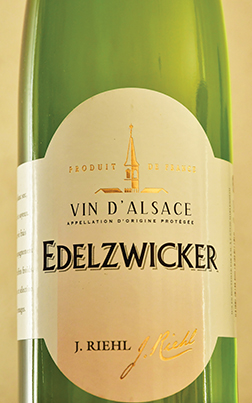
Beyond varietal wines, Alsace is also known for edelzwicker, a “noble blend” of white grapes.
Beyond varietal wines, Alsace is known for some blends including edelzwicker (which translates to “noble blend”). Edelzwicker is essentially a blend of all the white grapes in the Alsace AOP, with some exceptions. Outside of the AOP system there are a few more historical varieties you will find grown and produced, including Chardonnay, Klevener de Heiligenstein, Chasselas, and Auxerrois.
So much of what makes a wine Alsatian is the AOP system of wine grape production. Translating those grapes to wine is the other part of the story. Standard winemaking techniques are what you may see anywhere else — whole cluster pressing of whites, and either whole cluster fermentation or destemmed-only for the Pinot Noir. There is a growing movement to using less sulfur dioxide in the winemaking product, not because it is bad for winemaking, but the pH and acidity of these far northern latitudes support lower levels overall. Many of these wines are classified as organic, but it is worth knowing that the term organic takes on a different definition in Alsace and the European Union compared to the United States. In the U.S., sulfur dioxide is prohibited in a legally labeled organic wine. Whereas Jacques tells me organic means less sulfur dioxide in Alsace and other parts of Europe. Those rules are governed by the respective AOP.
Alsatian Grapes in the Vineyard
Great wines, regardless of which of the three AOPs it is labeled by, start in the vineyard. The vineyards employ unique growing practices that differ from those in most regions of France. It is hard to generalize what is practiced in Provence, Burgundy, Loire, and Bordeaux, but those regions mix and match training systems of gobelet, or vertically oriented cane-pruned vines with cordons low to the ground to absorb the earth’s warmth. Alsatian vine training techniques more closely resemble those of the vineyards of Germany. There, and in Alsace, cordons are placed about a meter (3.3 feet) above the ground to allow for cold air to flow underneath the developing canopy, reducing the risk of spring frost. Cane pruning is most common on 1- to 1.5-meter (3.3- to 5-foot) vine spacing. The vertically trained canes continue up another 2 meters (6.5 feet) from the cordon to the top wire. Hedging is done to the top of the canopy to keep the vines from spilling over and shading the vine behind it. The rows are spaced so that this now 2-meter (6.5-foot) leaf zone receives maximum sunlight exposure, and the fruit receives filtered sunlight. Therefore, vine row spacing will vary based on the slope of the hill and orientation to the sun. Of course, there is the obligatory ability to get a tractor down the row for a good spray program, hedging, weed control, and tilling. Cover crops are used to complement and help with the diversity of beneficial insects and add biomass to the soil when tilled in. Alsace is above the 48th parallel where the days are long. Located in the rainshadow of the Vosges Mountains, the Alsace valley enjoys abundant sunshine, which is essential to the flavor and color development of its wine grapes.
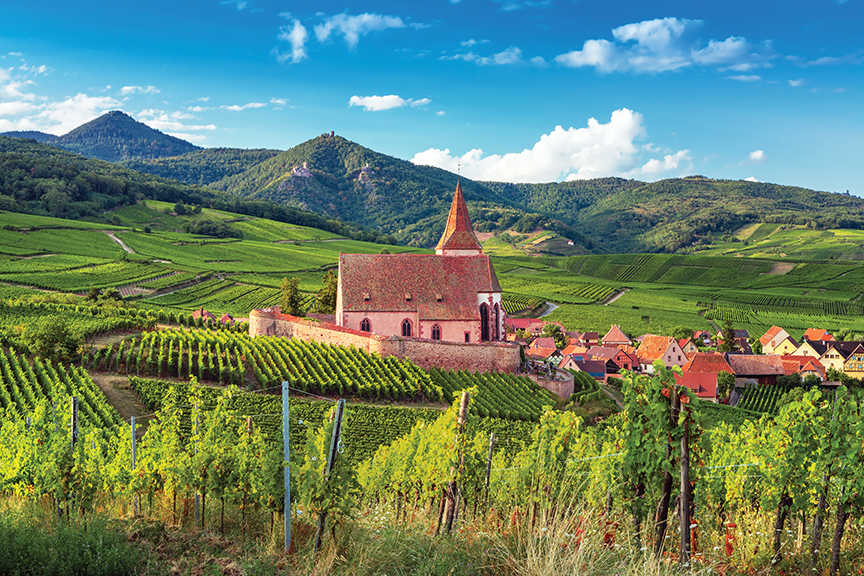
Harvest timing is crucial to any winemaking efforts, especially when the goal here is maximum aromatics from the whites, and good color expression in the Pinot Noir. Each vineyard will vary in its harvest timing, but the best winemakers regularly walk the vineyards as harvest begins to approach. In my own winemaking, this is when I begin to consider what I want the wine to be in three months. If you have the opportunity, walk the vineyards and pick random berries. If there are enough berries, take a sample of at least 100 from different spots in the vineyard and on the vines and evaluate the juice after crushing them in a plastic baggie. If there is not enough fruit, at least sample and taste berries individually, then go with your gut feeling. I harvest more on flavor. With Gewürztraminer, Dr. Maynard Amerine, a pioneering researcher at UC-Davis used to say, “If you are going to make good Gewürztraminer, you have to sleep in the vineyard.”
Making Alsatian-Style White Wines
Having successfully produced a beautiful grape in the vineyard, it’s time to translate that into wine. Winemakers employ standard processing measures, but as is often the case some come with a local twist. With the aromatic white grapes the main compounds responsible for grape aroma are located in the skins. A standard de-stem, crush, and press works well, especially on a small scale. The advantage here is that you can regulate your skin contact time. The preference would be maximum enhancement of aroma compounds and their precursors before you begin to extract bitterness and astringency.
Gauging exactly how long to keep the skin in contact with the juice is tough. A solution to getting around this is to employ a progressive contact process. Your first juice fraction being free run, with minimal to no skin contact and no pressing. Wait some time and collect the next fraction. If it drains freely, then pressing might not be necessary. If you do not have good flow, then a light press will do. Compare the color of the free run to that of this fraction. If it is still pale straw in color, then you can probably go longer. If you have the means, measure the pH of each fraction. Use the free run as a baseline and monitor for pH increases of more than 0.1. This indicates potassium is being leached from the cell walls. An increase in pH is a good indication that you are getting skin contact and you are almost at the end of your process, where the must should be pressed. As a rule, try to pull more juice early — this is generally considered the premium juice. It is very important to keep these juice fractions separate through fermentation so that you can evaluate the wine characteristics of each fraction after fermentation and then consider blending back the skin fractions. When tasting your individual wine fractions, look for bitterness or astringency in the finish. These are the fractions you want to blend in carefully so as not to make the entire batch taste overly astringent. However, these smaller fractions collected at the end contribute greatly to aromatics so they are worth adding in the right quantity.
The aforementioned process is a modification of what is done commercially. For those with more advanced pressing methods — that being a horizontal pneumatic membrane press — whole cluster pressing is the way to go. Most of these presses are programmable; so two very firm cycles of 1–1.5 bar will break the berries yielding free run juice. Tumble the press and do a series of light press cycles at 0.2–0.5 bar cycles, with a couple of rotations of tumbling between cycles. The cycles are quick. This is more of a process of “de-juicing” the must and results in a much higher quality juice than standard pressing procedures if done right. Granted, this is not really practical for the home winemaker’s vertically oriented bladder presses. Adapting this commercial process to your own setup is possible. The key is making sure the berries are fractured somewhat. If your press will break the berries that is ideal, or a quick run through the de-stemmer without crushing. Most of the berries take a mild thrashing as they drop through the beaters and basket so this level of fracture is sufficient. In the press, mix the must around between short press cycles.
Some Alsatian winemakers choose to ferment their wines with the native flora of their cellar. They follow in the footsteps of the previous generations in understanding their specific winery microbe populations. Some very good wines are the result. Others do not shy away from the use of commercial yeast strains. A couple of my favorites are Lallemand’s QA23 or CY3079. Using these yeasts is a good way to have a predictable outcome in your fermentation as they convert some of those flavor precursors in the juice to aromatic esters, otherwise known as fermentation bouquet. My personal experience has shown that CY3079 can leave a little residual sugar at lower temperature fermentation and complements the acidity profile. A little residual sugar can also help if your skin contact regimen was a little too long and you are working with some bitterness and astringency. Nothing like a bit of sugar to balance a wine in a subtle way. As Mary Poppins said once, “A spoonful of sugar helps the medicine go down.”
You must have the ability to control your temperatures to 55–60 °F (13–16 °C). It is the cool temperatures that favor the formation of the fermentation esters and retain them after the wines go into their aging period. Unless I am working with an acidity higher than around 8 g/L, I do not consider inoculating for malolactic conversion. That said, I am constantly looking at what the wine is now, and forward to where I want it to be in three months, so would not rule any winemaking technique out early in the process.
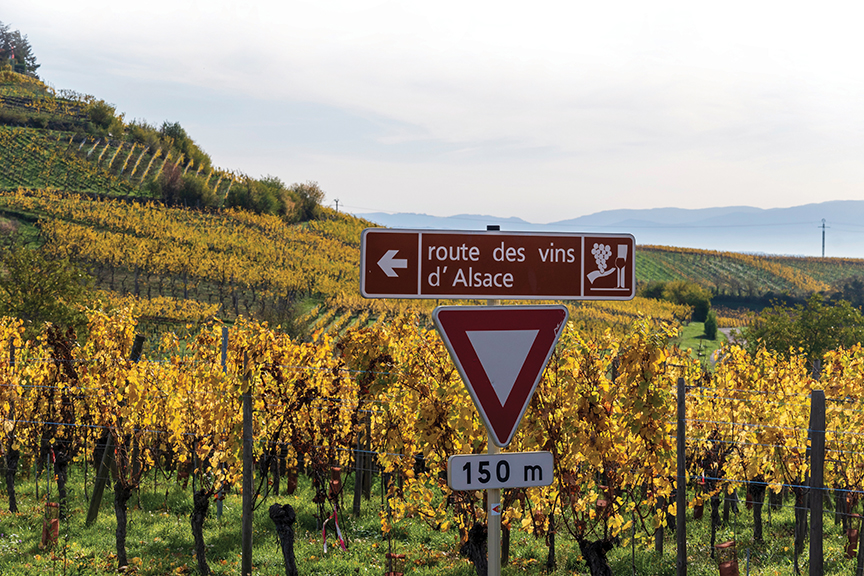
Tips for Pinot Noir
For Pinot Noir, getting the grapes’ color molecules into the finished wine requires a myriad of techniques that actually begin prior to harvest. The best Alsatian Pinot Noir is grown on the slopes in the Grand Cru that give the grapes maximum exposure to optimize anthocyanin development in the berries. Sound viticultural practices that maximize the grapes’ color are the best way to make a Pinot Noir with great color.
Winemakers for centuries have faced the challenge of translating color from grapes to wine, and the challenge is much greater with Pinot Noir. Regimens of cold soaking prior to fermentation, elevated temperature during fermentation, and seed removal are techniques Alsatian winemakers employ to help with this. There has been considerable research done on the mechanisms of color translation from grapes to wine, and more will certainly continue.
In the cellar with Pinot Noir, the focus is always on maceration techniques and fermentation. Winemakers in Alsace use a few different maceration techniques, sometimes including whole cluster fermentation. The whole cluster percentage varies from a few whole clusters being thrown into a de-stemmed and crushed batch to 100% whole clusters. The use of whole clusters is best accomplished with mature fruit from the vineyard indicated by brown stems with a firm woody character. Stems that are green will impart green vegetal characters. The mature fruit can add a little spice. You’ll find the right mix over time. De-stemming the clusters and fermenting the whole berries leads to fruitier wines. In some cases, fruit fermented in this way needs to be run through the crusher rollers prior to pressing, for the challenges of getting the berries broken. But there is nothing wrong with a standard de-stem and crush. One controversial topic of using dry ice during the de-stemming process does not hold merit with me. I call this a reductive processing technique. It is costly and the benefits of such a process have not been proven.
After de-stemming and crushing is when you should start being reductive in your techniques, especially if you are embarking on a cold soak style of maceration, which is commonly done with Alsatian Pinot Noir. Cold soak temperatures should be maintained at 40–45 °F (4–7 °C) with the headspace protected from oxygen with carbon dioxide, nitrogen, or argon. Winemakers often cold soak up to five days before allowing the must to warm and letting fermentation begin either naturally or through inoculation of a commercial yeast.
It was at one Alsace winery I was introduced to Metschnikowia pulcherrima, a non-Saccharomyces yeast with anti-microbial activity. When used in the cold soak period it has been shown to reduce the need for sulfur dioxide during cold soak, and with the long lag phase, it will initiate the fermentation at about five days. Since M. pulcherrima is only tolerant of alcohol to 6–7%, the must is then co-inoculated with your favorite Saccharomyces cerevisiae strain. I use Lallemand’s D254 but have also used EC-1118. Both yeasts are robust with the latter being a little more forgiving to the higher fermentation temperatures needed to help stabilize color. D254 has slightly higher nitrogen requirements.
All fermentations generate heat. You can maximize the benefits of a warm fermentation by allowing your cap temperatures to reach 88–92 °F (31–33 °C). This translates to a fermenting juice temperature in the low 80s °F (upper 20s °C). Be ready to employ some method of cooling to keep these temperatures maintained without going higher. It’s OK to see these warmer temperatures down to 1 or zero °Brix. Fermentations taking place in open top fermenters with a myriad of methods to punch down the cap are the norm in many wineries that produce Pinot Noir. Most winemakers making Pinot Noir agree that gentle processing techniques are best suited for this grape.
Looking Forward
While winemaking is no secret, the Alsatian traditions are deeply rooted in their history. Their political past has shaped their industry and now more urgently it is being influenced by warming global temperatures. A different kind of beast already being realized by earlier and earlier harvest seasons, long dry summers, and little winter rainfall. This is not unique to Alsace, but in these regions so rooted on tradition, it evokes a complex debate. The world now must deal with this changing environment for growing grapes and making wine from them. Laura told me if grapes could not still exist in their traditional Alsace, new varieties will have to replace them. And then what happens to their tradition? The thought of that makes me want to go back to the magic fridge and get another bottle.


